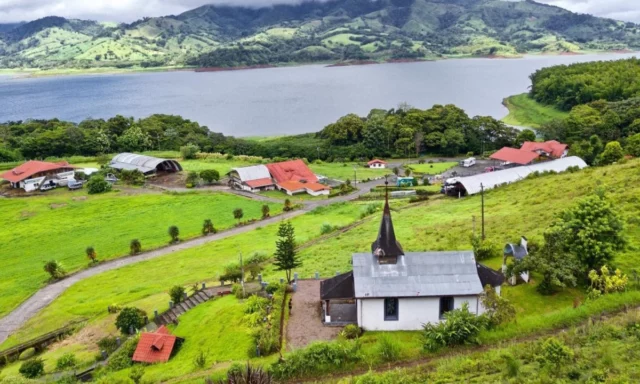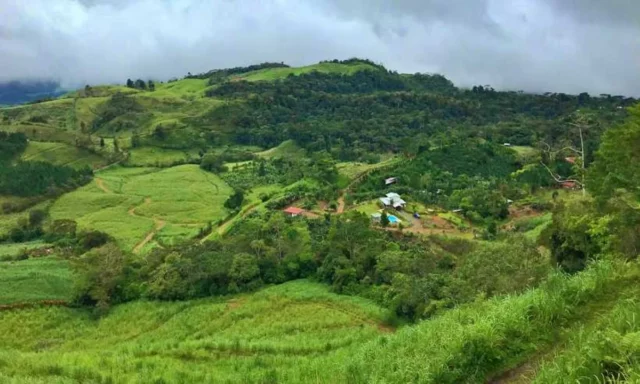For decades the notion has been propagated that Costa Rica is —in its own way— the Switzerland of Central America. In this regard, a couple of years ago, my colleague Gregorio Dauphin López, author of a substantial book on the life and work of the great Swiss botanist Adolphe Tonduz —resident in Costa Rica between 1889 and 1921—, asked me if I knew exactly who He was the first to draw that analogy. I replied that no, but that in the investigations for my historical books, he had come across some clues by chance several times, and nothing more.
Days later, intrigued by a possible relationship between Tonduz and Count Maurice de Périgny, who was in Costa Rica in 1913, he undertook the task of investigating this character, which led him to an article entitled French views of Central America. at the beginning of the 20th century: Maurice de Périgny and the Costa Rica of Hope (Estudios magazine, 2020) by historian friend Ronald Soto-Quirٕós, a prominent academic at the University of Bordeaux.
In this article, he transcribes several quotes from Périgny, who in 1917, when Europe was suffering from the convulsions of the First World War, stated the following: «Sure of the inviolability of its neutrality, the Republic of Costa Rica will fully deserve its nickname of American Switzerland, which had already earned it the beauty of its landscapes, the democratic spirit of its laws, the sweet and peaceful character of its inhabitants, the integrity and liberalism of its rulers. Likewise, it demonstrates that, the following year, these words were collected verbatim by the lawyer Ricardo Jiménez Oreamuno —who had been President of the Republic, between 1910 and 1914, and would be two more times—, in the introduction of a translation of his of the document The interoceanic railway route through the Republic of Costa Rica, by the famous German engineer Francisco Kurtze.

A bucolic setting in Vara Blanca, Heredia. Photo: Luko Hilje
Apparently, without meaning to, it was then Jiménez who cemented Périgny’s judgment of our country. However, critical as he was, in a later passage of his prologue he expressed that: «In the past, Kurtze called us the Chile of Central America, and Mr. de Périgny once called us, American Switzerland. I wish that those undeserved praises, in which flattery did not enter, instead of being an occasion to conceive ourselves, were an incentive to earn them fairly!».
Now, having clarified this matter thanks to Ronald’s investigations, what I want in this article is to compile some of the references to Costa Rica as an emulate nation of Switzerland, in the years prior to the arrival of Périgny. Surely there are more, but these are the ones I could find, which I record in chronological order.
The first comes from the German traveler Wilhelm Marr, who, heading towards Cartago with his compatriots Fernando Streber and Guillermo Witting on a spring morning in 1853, noted that “a little beyond the middle of the road, near a small village called Tres Ríos, By the three streams that surround it, there is the division of the waters and they run towards the Atlantic Ocean. The temperature changes there remarkably. Fresh mountain air, reminiscent of the heights of the Swiss Alps, greets the traveler when he reaches the top of the Cuesta del Fierro and from there looks down on the valley of Cartago. And what a valley! Streber was perhaps right in calling Cartago the jewel chest of Costa Rica, showcasing the richness of tropical vegetation, one can see in it meadows whose juicy tints are in no way inferior to the most beautiful of the greens of the North. The farmhouses with enclosed gardens and orchards resemble those of Appenzell, and except for the old volcano of Irazú, at the foot of which the city sits, one could swear that the most enchanting of Swiss valleys lies ahead.
About 5 years later, in 1858, it was the Irish traveler Thomas F. Meagher who would make a beautiful description of the rustic San José of that time, “radiant and resting in the midst of the palm trees that fan it; of the coffee trees; of the glossy, ready, and rich foliage of guavas and sweet lemon trees; of the orange and banana trees that sprout through the riot of red tiles, filling the serene air with perfumes; of the herds of oxen, the finest in the world, that graze in the pastures beyond the suburbs, or circulate busily and with great docility through the streets”. As a synthesis of his perceptions, he exclaimed: «May God protect the noble and brave city of the central Andes; the silent but hard-working city; the modest but prosperous city, the harmless but spirited Swiss metropolis of the Tropics».
Pastoral environment in Llano Bonito, Naranjo, Alajuela. Photo: Luko Hilje
Likewise, in a letter to his friend Charles P. Daly, dated in Cartago on April 24, 1858, he told him that he and his Venezuelan friend Ramón Páez Ricaurte, «until now we are grateful (and increasingly ecstatic) with the country. It is a beautiful land, most interesting and noble. As I have said in other letters, and as I have told the President of the Republic [Juan Rafael Mora] through my friend Ramón Páez, it is the Switzerland of the New World, compact, simple but graphic in its profile, which modestly resolves its allotted part in the history of the world, exhibiting much of what the most favored societies call “poverty” and, at the same time, revealing, far and wide, all the loftiness of nature, and a rugged defense behind which patriotism grows, strong and great in stature. I have not been extravagant in comparing it with the country of the Cantonal Confederation and the magnificent Lake of Uri».
A third traveler, the French journalist and diplomat Félix Belly, also in 1858, when alluding to the way we govern ourselves, expressed that «compare these very simple procedures with those of our European monarchies, always in struggle with the general will. It is not the peoples that are ungovernable; governments are incorrigible. The man from Costa Rica needs neither theatrical prestige nor armed force to make himself obeyed. Charlatanism finds no echo in the population; it only respects what deserves to be respected. For its part, the army is nothing more than a militia like that of Switzerland, and experience has proven that a country that stands up to defend itself is invincible. Good faith and justice, here is the palladium of powers and the secret of easy solutions, outside as well as inside. Thanks to this good faith, Costa Rica has gradually detached itself from all the enervating and ruinous traditions of its Spanish past to reach the most expeditious and economical governmental mechanism, as well as the most complete individual freedom.

Fourthly, the German doctor Carl Schwalbe, in 1888, when referring to the almost completed railway line between Puerto Limón and the capital San José, stated that «the railway is the problem child of Central American Switzerland. Before its construction the country was debt free; now he owes 60 million marks, that is, 300 marks per head». Later, he pointed out that “Costa Rica’s future rests above all on the further development and improvement of agriculture. That is the best foundation for a skillful and strong prosperity of the State. May the commitment of the Government of tropical Switzerland, keeping in mind the highest goals, find the most beautiful reward in the further opening and flourishing of the country”.
Finally, in 1917, the American journalist Hamilton Mercer Wright wrote that “the little Republic of Costa Rica is twice the size of Switzerland and could comfortably support a population of 20,000,000”. In a later passage of his extensive account, when referring to the Chirripó hill, the Poás and Irazú volcanoes and other peaks, he notes that «the glories of the Alps or the Andes, of the Canadian or American Rockies, do not exceed, in my opinion, to those of the Switzerland of Central America».
In summary, beautiful landscapes, delicious high altitude climates, the spirit of its citizens, as well as a republican and democratic regime which led several travelers to compare us with Switzerland at different times. True or not, what is indisputable is that the emergence of this denomination did not obey a local invention, conceived for chauvinistic purposes, but rather the opinions of some of those foreigners who traveled through our territory and penetrated the psyche or soul of its inhabitants. Note that it was a perception from different perspectives, which gradually consolidated and spread, until the Frenchman Périgny unified them all into a single concept.
Another curiosity is that —and this would have to be investigated— at an indeterminate moment we stopped being called “the Switzerland of America”, a description assigned to Uruguay until today, to be known as “Central American Switzerland”, an award that became popular and immortalized in the song ‘Mi Linda Costa Rica’, which has a catchy chorus that says: “Because it is so beautiful, they call Costa Rica the Central American Switzerland”. It should be noted that this joyous piece arose from the inspiration of the Nicaraguan musician Constantino (Tino) López Guerra, son of Celina Guerra Lizano, granddaughter of the Costa Rican Saturnino Lizano Gutiérrez, who held the presidency of Costa Rica in 1882, very briefly.
To conclude, and by way of a nice anecdote, when I worked at CATIE, in Turrialba, I had the Uruguayan Mario Pareja Viñoly, a specialist in weed science, as a colleague. One day Mario announced that he was leaving us and going to Geneva, since his wife at the time, Gilda Piaggio, had been appointed to an important position in the World Health Organization.
When he came to say goodbye to my office, before the sincere and warm farewell hug with which we endorsed a friendship that remains alive to this day, he told me: «You don’t know how lucky I have been in my life!!! I was born in the Switzerland of America, I have had the privilege of residing in Central American Switzerland, where I have lived near La Suiza de Turrialba, and now… I am going to the real Switzerland”. I think I barely managed to answer him: «Look, yes it is true! Be Swiss…”

